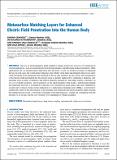Metasurface Matching Layers for Enhanced Electric Field Penetration Into the Human Body
Author(s)
Genovesi, Simone; Butterworth, Ian Richard; Cruz Serrallés, José E. (José Enrique); Daniel, Luca
DownloadPublished version (1.411Mb)
Publisher with Creative Commons License
Publisher with Creative Commons License
Creative Commons Attribution
Terms of use
Metadata
Show full item recordAbstract
The use of electromagnetic fields applied to human tissues has proven to be beneficial in several applications, such as monitoring physiological parameters and delivering medical treatments. Often applications rely on targeted energy deposition into the tissue, or rely on wireless powering of implanted devices. In such cases, the system energy efficiency, the stability of the field, and ultimately the process safety could all benefit from minimizing the mismatch at the air-skin interface. In this article, the maximization of the electric field transmitted into the muscle tissue is initially addressed by optimizing a dielectric-only matching layer in terms of thickness and relative dielectric permittivity, and under realistic constraints on low-cost available materials. The propagation of the electromagnetic field inside a multilayered medium that represents the body is evaluated by using the wave-transmission chain matrix approach. Furthermore, an innovative solution, based on the application of a metasurface matching layer (MML), is proposed to significantly improve the performance of the matching, thus enhancing the electromagnetic fields reaching the targeted muscle tissue. A thorough assessment of the performance is carried out considering both the presence of an air gap, and the case of plane waves impinging at oblique incidence.
Date issued
2020-10Department
Massachusetts Institute of Technology. Research Laboratory of ElectronicsJournal
IEEE Access
Publisher
Institute of Electrical and Electronics Engineers (IEEE)
Citation
Genovesi, Simone et al. "Metasurface Matching Layers for Enhanced Electric Field Penetration Into the Human Body." IEEE Access 8 (October 2020): 197745 - 197756.
Version: Final published version
ISSN
2169-3536